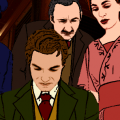The only video game Roger Ebert ever reviewed and enjoyed, Cosmology of Kyoto is a striking blend of history, philosophy, religion and myth. Intriguing and unsettling, the simple gameplay and rich storytelling lead to an experience that is sure to be long remembered.
The setting is 10th century Japan in the city of Kyoto. It is a time of unrest among humans, demons and ghosts alike. Portions of the city are beautiful, while others lay in shambles. Human life is a cheap, and death comes easily at the end of a sword or by the jaws of a monster. The game makes no attempt to hide sex or violence, and it features many mature themes and situations. Thankfully, most of the graphics are hand drawn rather than computer generated, and they manage to hold up very well. The vast majority of the game is seen from a first-person perspective, and the graphics are mostly static, with only light touches of animation. Whether you encounter a beautiful woman, a pitiful beggar or an enraged demon, the game more than manages to get its point across. Music and sound effects in the game are extremely subtle, adding small accents to various events. The speech audio is in the original Japanese with English subtitles, which adds to the sense of authenticity permeating the whole experience.
The game opens with options for character creation. It is important to remember the name you give your character, because it doubles as the password when you restore a saved game. You are then able to choose what your avatar will look like, but don’t be too picky – you will die sooner or later and be reincarnated as a completely different person, complete with an entirely new look. If you possess the game’s actual written instructions or the included map, they will do you little good. For all intents and purposes, you are thrown outside the city gates without a dime to your name or a stitch of clothing. In the absence of any stated goals, you proceed to explore the city.
Gameplay is extremely basic, using the simplest of point-and-click systems. It all boils down to exploring Kyoto and living out legends, conversations, and everyday experiences of the time. There are also occasionally easy puzzles or short conversations where you must type in your response. Inventory items are mostly useless, or only used in otherwise nonessential plotlines. There is only one item that is absolutely essential for the completion of the game. As for the story, there is a decent balance between the presentation of events from recorded history and those from myths. For instance, at one point you witness the destruction of a building, which actually happened, and speak to a historic ruler. You are also shown the metaphysical side of the disaster, that demons or ghosts were ultimately responsible.
The most common supernatural tales in the game are classic ghost stories. Your character meets a woman, is led to a dark place, and then something horrible happens. Variations on this theme occur several times, and each one is related to actual Japanese folklore. Cosmology of Kyoto is full of these side-stories. There is an overall plot in only the loosest sense; to progress, there are certain events that must be triggered, but between these events you are welcome to do whatever you like. You can give your alms to the poor or lose them in a cock fight; it’s entirely up to you. But it’s only when you journey deeper and deeper into the city that you find your ultimate destiny, experiencing the circle of death and rebirth as you go.
Throughout the game and even outside of it, you have access to a reference file that explains aspects of ancient Kyoto, including its history and its culture. The entire library is always available, but it first gives you topics related specifically to what you are currently witnessing. For instance, if you see a flaming rock crashing down from the sky, clicking on the reference button will bring up an article about the Kanzan Stone, a sacred meteorite that is still worshiped today. These tidbits are in no way necessary to continue in the game itself, but they are extremely interesting. This simple attempt to enlighten the player would be a welcome addition to many games.
One of the most brilliant elements in the game is its handling of character death. When you die, and you most assuredly will, you experience one of a variety of hells described in Buddhism. In these hells, your character is tortured in a wide variety of gruesome ways. You are then reincarnated either as another human or as something else. At one point, you witness a dog eating the entrails of a corpse before being devoured itself by a larger dog. You might very well find yourself reincarnated as that doomed dog, and then the cycle repeats itself.
Made at a time when designers were still figuring out how to utilize the CD-ROM format, Cosmology of Kyoto attempts to be many things: a game, an educational tool, and a work of art. Unbelievably, it manages to be all of these and more.


